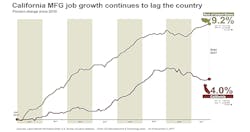The sixth annual California Economic Summit was held on November 2nd – 3rd in San Diego. The summit was convened by CA Fwd and the California Stewardship Network, with a long-list of sponsors and partners. More than 500 civic, business, attended the event held at the Hilton San Diego Bayfront. The theme of the summit was Elevate California with the goal of achieving:
- 1 million more skilled workers
- 1 million more homes
- 1 million more acre-feet of water
The statewide gathering highlighted higher education as an important component to a new initiative to restore upward mobility in the state. I was only able to attend day two, which began with a welcome by Mark Cafferty, president of the San Diego Regional Economic Development Corp., and San Diego County Supervisor Greg Cox. Cafferty said, “California’s brand around the world is remarkable. We need to prepare and support our most important assets – people. We need to help Californians live in sustainable communities, and we need to create 1 million more middle class jobs to ‘future proof’ California for Californians.”
Supervisor Cox said, “We now have 1,400 ‘Blue tech’ companies representing 46,000 employees and making a $14 billion contribution to our economy, creating blue collar and white-collar jobs.” He mentioned that according to the recent report, the impact of the military represents 22% of the region’s jobs.
The day started with a panel of millennial and Next Gen leaders discussing their perspective on how California’s economy and the high cost of living are affecting them and their peers. Christine Werstler was the panel leader, and the panelists were: Assemblywomen Autumn Burke, Sean Bhardwaj, founder and CEO of Aspire 3, and Laura Clark of YIMBY Action. They shared that the major challenges are: affordable housing, access to fundamental services like health care and education, rapid change and an unknown future.
Assemblywoman Burke said, “You can only do so much with legislation. We need to provide resources. It’s important to know that we have a college system that doesn’t have room for everybody, even if they qualify. Access to education should be a high priority.” Burke added that many of those are students from disenfranchised communities. Burke said, “We have the data, and now we need to put it into action and work with private industry to provide the opportunities and resources. It is our job as legislators to provide all of the things they need. “
Panelist Sean Bhardwaj said, “We need to teach entrepreneurism as a skill across disciplines in colleges and universities so they are prepared to find and create their career opportunities for the future. Only 19% of millennials see other people as trustworthy, 10% lower than other generations. They need to build personal relationships or they will not engage.”
Bhardwaj added, “Each and every one of us has a talent and a skill that we can bring to the world. We need to break out of the thinking of what we think learning is and think what it could be. Technology is a tool to make resources more accessible. We need to look at what are the tools we can provide so we can use the tools quickly. We need to figure out what are the skills needed today and quickly provide the opportunities to learn them.”
Clark said, “Millennials are angry – 20% are living in poverty, and we need to bring them up. It is important to have clustering of industries in regions to provide career advancement.” She urged institutions to make sure college students are registered to vote so they have a voice on issues including funding.
The next panel featured leaders from all three of the state's public higher education systems: University of California President Janet Napolitano, California State University Chancellor Timothy White and California Community Colleges Chancellor Eloy Ortiz Oakley. Ryan Smith was the panel leader.
“When we think about income inequality in our country and California, the single tried and true tactic that has worked over time has been access to higher education in terms of increasing social mobility,” said Napolitano. “When I remind people that 45% of the entering class at University of California are first-generation college students, that’s real opportunity that public higher education presents in California. In the UC system, we have increased enrollment by 10% in the last two years.”
When asked about affordability, the leaders emphasized the widespread use of financial aid to cut tuition and fees, but reminded the audience that the total cost of education also includes California's high housing costs and other expenses.
Chancellor White said, “There is a capacity problem. We turn away about 30,000 students every year. We need to build more capacity. If we don't make this investment, it will be a higher cost in the future if we don't succeed."
Ortiz Oakley said, “We are in 114 communities and we need to design for the future jobs, so we are looking at what are the job needs of different regions to create upward mobility and train more skilled workers needed across the state. We’ve spent a lot of time and fortunately we’ve had the investment over the last several years through the Strong Workforce to take a hard look at the regions of California to begin preparing ourselves to develop curricula for the jobs of today and the future, not the jobs of yesterday.”
All three of the Democrat gubernatorial candidates appeared at the Summit. I missed the appearance of Lt. Governor Gavin Newsom the first day, but day two, former Los Angeles Mayor Antonio Villaraigosa and State Treasurer John Chiang were interviewed. Villaraigosa said, “If it were a country, California would rank sixth in the world economies, but we rank down with Romania in the level of poverty.” He agreed with Assemblywoman Burke. “If we’re going to survive and thrive, we’re going to have to do a better job at growing middle class jobs," adding that 60% of high school kids are Latino and African American, but only 13% go on to a four-year college. He said, “We’ve got to address that. We’ll be a million and half down in college graduates by 2025 and a million down in people with specialized skills.”
Chiang said, “We have to understand that we ought to celebrate the diversity of our resources. It’s all about the people and I believe we have an area that is the magnet that draws people. It’s the idea of what California is, so we can flourish uniquely because of the extraordinary diversity that we have.”
Manufacturing Job Loss and Poverty
The 2017 summit sought to advance these ambitious themes during the event and in the coming year:
- Create a unifying triple-bottom-line vision for increasing economic security and upward mobility
- Expand the strength and diversity of the summit network to increase its influence on state and local policy decisions
- Mature the summit as a formal civic partner with government to advance triple-bottom-line policies:
While I applaud the goals of the summit co-conveners and partners, I wonder why no one seemed to connect the fact that our losing 33% (618,000) of our higher-paying manufacturing jobs from the year 2000 -2010 might be a major cause of our increased rate of poverty.
According to data from the California Manufacturing Technology Association, we have only regained about 50,000 manufacturing jobs since then. As shown by the following chart from CMTA Champions of Manufacturing blog by Vice President Gino diCaro, California is lagging behind the rest of the country in regaining manufacturing jobs, and California only attracted 1.6% of reshored jobs from 2013 – 2016.
For 20 years, the Small Business & Entrepreneurship Council has published a report, titled the Small Business Policy Index, by their Chief Economist, Raymond J. Keating, which ranks the states on policy measures and costs impacting entrepreneurship and small business growth. According to the 2016 report, California ranks dead last, and has been dead last for several years. The report “ties together 50 major government-imposed or government-related costs impacting small businesses and entrepreneurs” across a broad spectrum of industries and types of businesses, which include: corporate and personal income tax rates, individual and corporate capital gains taxes, property taxes, sales, growth receipts, and excise taxes, death taxes, unemployment tax rates, gas and diesel tax rates, workers’ compensation premium costs, energy regulation, state minimum wage, paid family leave, etc. It even ranks states by the number of government employees, per capita state and local government spending, per capita state and local government debt, and various categories of lawsuit reform.
A brief look at how California ranks reveals:
- California has the highest personal income tax rate and individual capital gains tax at 13.3%
- California ranks 50th in workers’ compensation premiums cost at 3.48
- California ranks 49th in energy regulatory costs
- California ranks 43rd in corporate income taxes and 44th in corporate capital gains tax at 8.84%
On the plus side, California ranks first in the lowest unemployment taxes at the low rate of 0.81. Thanks to Proposition 13 still being in effect, California only ranks 22nd in property taxes at 2.835%. In 2016, California only ranked 46th in gas taxes at 0.409 cents per gallon, but would rank 49th now after raising its gas taxes by 12 cents per gallon the week after the summit.
As long as California’s legislators and other leaders have their “head in the sand,” nothing will be done about improving the business climate of California. I challenge the state legislature to do their job as legislators to provide all of the things business needs to grow and expand employment.
At the conclusion of the summit, Oscar Chavez, assistant director at the Sonoma County Department of Human Services, announced that Sonoma County will be the site of the 2018 California Economic Summit. He said, "You cannot sit on the sidelines. This state needs you." I would say, “This state needs leaders who address the issues affecting manufacturing if we want to achieve the lofty goals of the summit."




